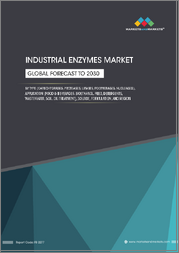
|
시장보고서
상품코드
1621862
섬유 효소 시장 기회와 성장 촉진요인, 산업 동향 분석 및 예측(2024-2032년)Textile Enzymes Market Opportunity, Growth Drivers, Industry Trend Analysis, and Forecast 2024 - 2032 |
||||||
세계 섬유 효소 시장은 2023년 4억 5,930만 달러로 평가되었고, 2024-2032년간 연평균 5.4% 성장할 것으로 예상됩니다.
생화학 반응을 촉진하는 섬유 효소는 섬유 생산에 사용되는 화학 기반 공정에 대한 환경 친화적 인 대안을 설명합니다. 이 효소는 바이오 연마, 탈색, 표백, 염색 등 다양한 생산 단계에 필수적이며, 직물의 품질을 향상시키는 동시에 물 소비량, 에너지 사용량 및 처리 시간을 줄이는 데 도움이 됩니다. 섬유 산업이 보다 지속 가능한 관행을 채택해야 한다는 압력이 증가함에 따라 효소 기반 솔루션에 대한 수요가 증가하고 있습니다. 섬유 효소는 표백 및 탈색과 같은 공정을 저온에서 수행할 수 있게 함으로써 에너지 비용을 절감하고, 더 적은 화학물질로 더 부드럽고 매끄러운 직물을 생산할 수 있게 해줍니다.
그 결과, 효소 사용은 더 큰 효율성과 더 작은 환경 발자국으로 이어집니다. 그러나 섬유 효소는 온도 및 pH 수준과 같은 환경적 요인에 민감하여 성능에 영향을 미칠 수 있습니다. 이러한 민감성은 특히 산업 환경이 엄격하게 관리되지 않는 지역에서는 물류상의 문제가 될 수 있습니다. 효소의 최적 사용을 보장하기 위해 제조업체는 적절한 보관 및 적용을 위한 전문 장비와 숙련된 인력이 필요하며, 이는 비용 증가로 이어집니다.
이러한 비용과 효소의 장점의 균형을 맞추는 것이 산업에서 효소의 보급을 방해하는 요인으로 작용하고 있습니다. 효소 유형에 따라 시장은 셀룰라아제, 프로테아제, 아밀라아제, 리파아제, 기타로 나뉩니다. 셀룰라아제는 2023년 2억 1,430만 달러 시장을 창출할 것으로 예상되며, 바이오 연마 및 직물 유연화 분야에서 폭넓게 사용되어 시장을 독점하고 있습니다. 이 효소들은 셀룰로오스 섬유를 분해하여 직물의 질감을 향상시키고 보풀을 줄이면서 매끄러운 마무리를 설명합니다.
| 시장 범위 | |
|---|---|
| 시작 연도 | 2023년 |
| 예측 연도 | 2024년-2032년 |
| 시작 금액 | 4억5,930만 달러 |
| 예상 금액 | 7억 3,320만 달러 |
| CAGR | 5.4% |
섬유 제조업체들에게 지속가능성이 점점 더 중요해지면서 셀룰라아제는 유해한 화학물질을 사용하지 않고도 직물의 품질을 향상시킬 수 있다는 점에서 선호되고 있습니다. 공급원에 따라 시장은 동물 조직 유래 효소, 식물 유래 효소, 미생물 유래 효소로 나뉘며, 2023년 미생물 효소는 비용 효율성, 확장성, 효율성으로 인해 63.9%의 큰 시장 점유율을 차지할 것으로 예상됩니다. 박테리아, 곰팡이 등 미생물 유래 효소는 안정성과 수율이 높아 대규모 산업 응용에 적합합니다.
견조한 섬유 산업과 친환경 생산에 중점을 둔 아시아태평양은 2023년 1억 6,510만 달러의 수익을 창출했으며, 이는 이 지역이 지속 가능한 제조 솔루션에 중점을 두고 있다는 것을 반영합니다. 아시아태평양의 섬유 효소 시장은 섬유 산업 확대와 친환경 생산 관행에 대한 노력으로 2023년 1억 6,510만 달러의 수익을 창출할 것으로 예상됩니다. 중국, 인도, 방글라데시 등 주요 섬유 제조 거점들은 전 세계 섬유 생산에서 중요한 역할을 하고 있습니다. 이 지역은 탄탄한 산업 인프라, 경쟁력 있는 인건비, 섬유 수출을 지원하는 유리한 정부 정책의 혜택을 누리고 있으며, 이는 바이오 연마, 탈지, 염색 등 다양한 생산 공정에서 섬유 효소의 채택을 촉진하고 있습니다.
목차
제1장 조사 방법과 조사 범위
제2장 주요 요약
제3장 산업 인사이트
- 생태계 분석
- 주요 제조업체
- 유통업체
- 산업 전체 이익률
- 산업에 대한 영향요인
- 성장 촉진요인
- 시장이 해결해야 할 과제
- 시장 기회
- 새로운 기회
- 성장 가능성 분석
- 원료 상황
- 제조 동향
- 기술 진화
- 원료 지속가능성
- 사스테이나불 제조
- 그린 프랙티스
- 탈탄소화
- 가격 동향(달러/톤), 2021-2032년
- 규제와 시장에 대한 영향
- Porter's Five Forces 분석
- PESTEL 분석
제4장 경쟁 구도
- 서론
- 기업 매트릭스 분석
- 기업 점유율 분석
- 지역별 기업 점유율 분석
- 북미
- 유럽
- 아시아태평양
- 라틴아메리카
- 중동 및 아프리카
- 지역별 기업 점유율 분석
- 경쟁 포지셔닝 매트릭스
- 전략 대시보드
제5장 시장 규모와 예측 : 유형별, 2021-2032년
- 주요 동향
- 셀룰라아제
- 프로테아제
- 아밀라아제
- 리파아제
- 기타(펙티나아제, 키시라나제, 락카제 등)
제6장 시장 규모와 예측 : 공급원별, 2021-2032년
- 주요 동향
- 동물 조직
- 식물
- 미생물
제7장 시장 규모와 예측 : 용도별, 2021-2032년
- 주요 동향
- 바이오 연마
- 바이오 쏘싱
- 표백
- 염색
- 탈색
- 기타(씻어, 마무리 등)
제8장 시장 규모와 예측 : 지역별, 2021-2032년
- 주요 동향
- 북미
- 미국
- 캐나다
- 유럽
- 독일
- 영국
- 프랑스
- 이탈리아
- 스페인
- 아시아태평양
- 중국
- 인도
- 일본
- 한국
- 호주
- 라틴아메리카
- 브라질
- 멕시코
- 아르헨티나
- 중동 및 아프리카
- 사우디아라비아
- 아랍에미리트
- 남아프리카공화국
제9장 기업 개요
- AB Enzymes
- Advanced Enzymes
- Antozyme BIoTech Pvt. Ltd.
- BASF SE
- Bestzyme Bio-Engineering Co., Ltd.
- Denykem
- Epygen Labs LLC
- Infinita BIoTech Private Limited
- Kemin Industries, Inc
- Noor Enzymes
- Novozymes
- Sunsong Industry Group Co., Ltd.
- Tex Biosciences
The Global Textile Enzymes Market was valued at USD 459.3 million in 2023 and is projected to expand at a CAGR of 5.4% from 2024 to 2032. Textile enzymes, which accelerate biochemical reactions, provide an eco-friendly alternative to chemical-based processes used in textile manufacturing. These enzymes are integral to various stages of production, such as bio-polishing, desizing, bleaching, and dyeing, helping to improve fabric quality while also reducing water consumption, energy use, and processing time. With increasing pressure on the textile industry to adopt more sustainable practices, the demand for enzyme-based solutions is on the rise. Textile enzymes enable manufacturers to produce softer, smoother fabrics with fewer chemicals while cutting energy costs by allowing processes like bleaching and desizing to occur at lower temperatures.
As a result, enzyme use leads to greater efficiency and a smaller environmental footprint. However, textile enzymes are sensitive to environmental factors like temperature and pH levels, which can impact their performance. This sensitivity poses logistical challenges, especially in regions where industrial environments may lack strict controls. To ensure the optimal use of enzymes, manufacturers need specialized equipment and trained personnel for proper storage and application, leading to higher costs.
Balancing these costs with the benefits of enzymes is a challenge that hinders their wider adoption in the industry. The market is segmented by enzyme type into cellulases, proteases, amylases, lipases, and others. Cellulases generated USD 214.3 million in 2023, dominating the market due to their wide application in bio-polishing and fabric softening. These enzymes enhance fabric texture by breaking down cellulose fibers, offering a smoother finish while reducing pilling.
| Market Scope | |
|---|---|
| Start Year | 2023 |
| Forecast Year | 2024-2032 |
| Start Value | $459.3 Million |
| Forecast Value | $733.2 Million |
| CAGR | 5.4% |
As sustainability becomes increasingly vital for textile manufacturers, cellulases are favored for their ability to improve fabric quality without the use of harmful chemicals. Based on the source, the market is divided into enzymes derived from animal tissue, plants, and microbes. In 2023, microbial enzymes held a significant 63.9% market share due to their cost-effectiveness, scalability, and efficiency. Enzymes from microbes, such as bacteria and fungi, offer high stability and yield, making them ideal for large-scale industrial applications.
The Asia-Pacific region, with its robust textile industry and emphasis on eco-friendly production, generated USD 165.1 million in 2023, reflecting the region's growing focus on sustainable manufacturing solutions. Asia Pacific textile enzymes market generated revenue of USD 165.1 million in 2023, driven by the expanding textile industry and commitment to eco-friendly production practices. Major textile manufacturing centers like China, India, and Bangladesh play a crucial role in global textile output. The region benefits from a robust industrial infrastructure, competitive labor costs, and favorable government policies supporting textile exports, which have collectively boosted the adoption of textile enzymes in various production processes, including bio-polishing, desizing, and dyeing.
Table of Contents
Chapter 1 Methodology & Scope
- 1.1 Market scope & definition
- 1.2 Base estimates & calculations
- 1.3 Forecast calculation
- 1.4 Data sources
- 1.4.1 Primary
- 1.4.2 Secondary
- 1.4.2.1 Paid sources
- 1.4.2.2 Public sources
Chapter 2 Executive Summary
- 2.1 Industry 360° synopsis
Chapter 3 Industry Insights
- 3.1 Industry ecosystem analysis
- 3.1.1 Key manufacturers
- 3.1.2 Distributors
- 3.1.3 Profit margins across the industry
- 3.2 Industry impact forces
- 3.2.1 Growth drivers
- 3.2.2 Market challenges
- 3.2.3 Market opportunity
- 3.2.3.1 New opportunities
- 3.2.3.2 Growth potential analysis
- 3.3 Raw material landscape
- 3.3.1.1 Manufacturing trends
- 3.3.1.2 Technology evolution
- 3.3.1.3 Sustainability in raw materials
- 3.4 Sustainable manufacturing
- 3.4.1.1 Green practices
- 3.4.1.2 Decarbonization
- 3.5 Pricing trends (USD/Ton), 2021 to 2032
- 3.5.1.1 North America
- 3.5.1.2 Europe
- 3.5.1.3 Asia Pacific
- 3.5.1.4 Latin America
- 3.5.1.5 Middle East & Africa
- 3.6 Regulations & market impact
- 3.7 Porter's analysis
- 3.8 PESTEL analysis
Chapter 4 Competitive Landscape, 2023
- 4.1 Introduction
- 4.2 Company matrix analysis
- 4.3 Company market share analysis
- 4.3.1 Company market share analysis by region
- 4.3.1.1 North America
- 4.3.1.2 Europe
- 4.3.1.3 Asia Pacific
- 4.3.1.4 Latin America
- 4.3.1.5 Middle East Africa
- 4.3.1 Company market share analysis by region
- 4.4 Competitive positioning matrix
- 4.5 Strategic dashboard
Chapter 5 Market Size and Forecast, By Type, 2021-2032 (USD Million, Kilo Tons)
- 5.1 Key trends
- 5.2 Cellulases
- 5.3 Proteases
- 5.4 Amylases
- 5.5 Lipases
- 5.6 Others (pectinases, xylanases & laccases etc.)
Chapter 6 Market Size and Forecast, By Source, 2021-2032 (USD Million, Kilo Tons)
- 6.1 Key trends
- 6.2 Animal tissue
- 6.3 Plants
- 6.4 Microbes
Chapter 7 Market Size and Forecast, By Application, 2021-2032 (USD Million, Kilo Tons)
- 7.1 Key trends
- 7.2 Bio-polishing
- 7.3 Bio-sourcing
- 7.4 Bleaching
- 7.5 Dyeing
- 7.6 Desizing
- 7.7 Others (washing, finishing etc.)
Chapter 8 Market Size and Forecast, By Region, 2021-2032 (USD Million, Kilo Tons)
- 8.1 Key trends
- 8.2 North America
- 8.2.1 U.S.
- 8.2.2 Canada
- 8.3 Europe
- 8.3.1 Germany
- 8.3.2 UK
- 8.3.3 France
- 8.3.4 Italy
- 8.3.5 Spain
- 8.4 Asia Pacific
- 8.4.1 China
- 8.4.2 India
- 8.4.3 Japan
- 8.4.4 South Korea
- 8.4.5 Australia
- 8.5 Latin America
- 8.5.1 Brazil
- 8.5.2 Mexico
- 8.5.3 Argentina
- 8.6 MEA
- 8.6.1 Saudi Arabia
- 8.6.2 UAE
- 8.6.3 South Africa
Chapter 9 Company Profiles
- 9.1 AB Enzymes
- 9.2 Advanced Enzymes
- 9.3 Antozyme Biotech Pvt. Ltd.
- 9.4 BASF SE
- 9.5 Bestzyme Bio-Engineering Co., Ltd.
- 9.6 Denykem
- 9.7 Epygen Labs LLC
- 9.8 Infinita Biotech Private Limited
- 9.9 Kemin Industries, Inc
- 9.10 Noor Enzymes
- 9.11 Novozymes
- 9.12 Sunsong Industry Group Co., Ltd.
- 9.13 Tex Biosciences



















